One of the most impressive things about Bobby Fischer’s 60 Memorable Games was his inclusion of two losses, which is not normally done in a “greatest games” collection. But he called his book memorable games for a reason. I think he was not interested in idle bragging; he wanted to show his readers games that they could learn from, and what could be better than the games where he himself had learned something — by making mistakes and having them punished?
So it is only fair that for one of my six memorable games I should show you a loss, and after a lot of thought I’ve decided to show you the most stunning combination that anybody has ever played against me. It wasn’t played by a GM, or an IM, or any kind of M: it was a “lowly” Class-A player from North Carolina named Thomas Waymouth. According to the USCF ratings page, he briefly made it to expert in 2000 and again in 2004, but he has not played a rated game since 2007. But in this one game he played like a champion, and wherever he is today, he deserves to be proud of it.
Dana Mackenzie – Thomas Waymouth
U.S. Open, 1998
1. e4 e5 2. Nf3 Nc6 3. Bb5 f5 4. d4 …
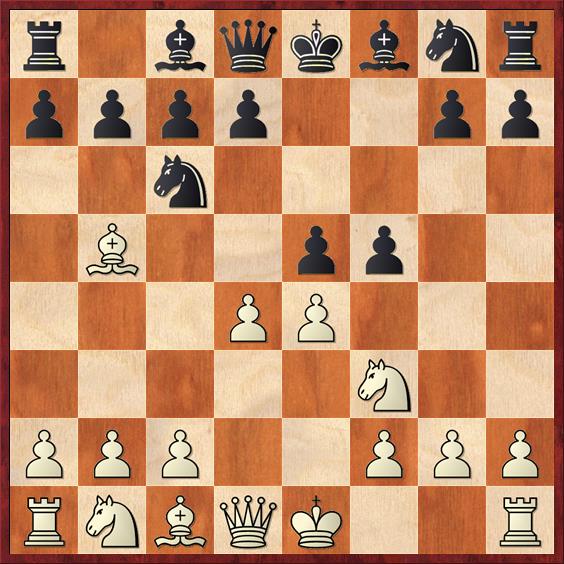 Position after 4. d4. Black to move.
Position after 4. d4. Black to move.
FEN: r1bqkbnr/pppp2pp/2n5/1B2pp2/3PP3/5N2/PPP2PPP/RNBQK2R b KQkq – 0 4
I don’t want to spend too much time on the opening because there’s so much excitement later. But the Janisch (Schliemann) Defense, 3. … f5, is probably a good choice for a lower-rated player against a higher-rated one. The most testing response is supposed to be 4. Nc3, but after 4. … fe 5. Nxe4 d5 it’s pure tactics. If you’re the higher-rated player, you don’t want a pure tactical slugfest where you might overlook some little trick that changes the complexion of the game.
I like 4. d4 here, because it’s strategically the most logical move. That being said, however, I don’t even play the Ruy Lopez as White any more because my results with it were pitiful — barely over 50 percent, which is bad for a White opening. Nowadays I play the King’s Gambit, with which I have had much more success.
4. … fe 5. Bxc6 …
I knew about the trick 5. Nxe5!? Nxe5 6. de c6!, after which White loses a pawn to … Qa5+ if he retreats the bishop. However, an interesting option (which I may not have known at the time of this game) is to sacrifice a piece with 7. Nc3! cb 8. Nxe4 d5 9. ed. I think that psychologically this is a wonderful way to play against Janisch Gambit players. They were expecting to sac a pawn and get a big kingside attack. Instead they are now the ones facing an arduous defense, with an exposed king and weaknesses all over the place.
5. … bc 6. Nxe5 Nf6 7. O-O Be7 8. c3 Rb8
Black would like to castle, but needed to stop Qb3 (+) first.
9. Qa4? …
I don’t like this move, which seems too coffeehouse-ish to me. Here’s why. White is already getting a little bit behind in development, and he needs to resolve the issue of how to get the inactive queenside pieces into the game. These are the “ugly pieces.” The queen is a “pretty piece” — there are lots of things it can do. One of the most important lessons I learned from Jesse Kraai is to avoid the temptation to play with your pretty pieces all the time. We don’t even know yet what the best place for the queen will be, whether to go to the kingside or queenside. So we should stay flexible, keep the opponent guessing, and give ourselves more options.
9. … Rb6 10. Re1 d5 11. c4 Ra6 12. Qd1 …
A-a-a-and the queen goes back home. All of the queenside pieces are still at home, and the queen has arguably wasted two tempi.
Now, however, my opponent makes a serious strategic mistake.
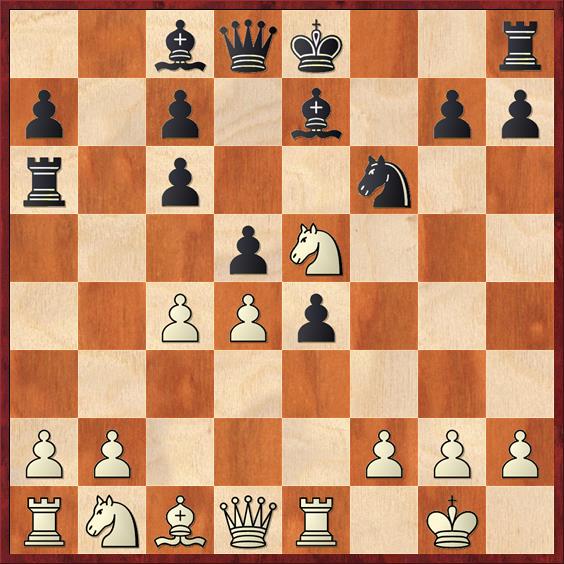 Position after 12. Qd1. Black to move.
Position after 12. Qd1. Black to move.
FEN: 2bqk2r/p1p1b1pp/r1p2n2/3pN3/2PPp3/8/PP3PPP/RNBQR1K1 b k – 0 12
12. … O-O?
You should only castle if there is nothing better to do! In this position, Black urgently needs to give his rook on a6 some air, and the correct move was 12. … c5! I can understand that Black was afraid to open up the position with his king still in the center. But Black’s pieces are beautifully developed, while White has only two pieces developed — and the knight on e5 could easily turn into a target. Black just has to have faith that with his much superior pieces he will be able to swat away any threats on his king.
13. c5! …
Obviously I wasn’t going to give him another chance! My center is now secure and his rook is imprisoned — I thought — at a6 forever.
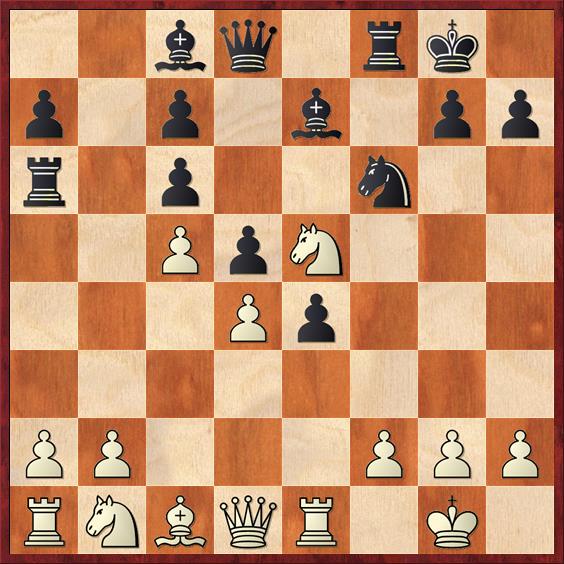 Position after 13. c5. Black to move.
Position after 13. c5. Black to move.
FEN: 2bq1rk1/p1p1b1pp/r1p2n2/2PpN3/3Pp3/8/PP3PPP/RNBQR1K1 b – – 0 13
Let’s talk about this position, because it is the most important position of the game — more important even than the one where he launches his beautiful winning combination. It is this position, and especially my misconceptions about it, that set the wheels of fate turning toward my inevitable doom.
My thinking here was, essentially, “I have a strategically won game.” White has a simple winning plan: play b4, a4-a5, avoid getting checkmated on the kingside somehow, and trade off all the other pieces. If I can get down to an endgame with my rook against his rook on a6, I win because his rook has no moves. I’m effectively a rook ahead.
There’s a famous game Capablanca-Winter, 1919, where Capablanca wins in just this fashion. He sets up a position where Winter’s bishop can never ever get out of jail, and then just plays on the other side of the board where he is effectively a piece ahead. Jesse Kraai, in his lecture on the game, calls it a “wintered bishop.”
What is the difference between a wintered piece and a trapped piece? A trapped piece is only temporarily unable to move. For example, knights or queens on a1 (a8) are often in this situation. For the other player, there is a clock ticking: either you win the piece in two or three or four moves, or it gets out. A wintered piece is one that can never get out. So there is no rush to win it, and in fact I would say that part of the definition of a wintered piece is that it is in no immediate danger. The way to exploit a wintered piece is not to win it, but to take advantage of its absence from the rest of the board. Finally, it is important that the trap is maintained by pieces of smaller value. If your opponent’s rook is trapped but you have to tie down one of your own rooks to keep it trapped, then it is not wintered.
So my thinking was that Black had a wintered rook, and would inevitably lose. I didn’t express it in those words, of course; it was still ten years before I would hear Jesse’s lecture, so I didn’t have a word for the concept.
What went wrong? First, I failed to understand that the rook is not wintered yet. It will only be wintered after b4 and a4-a5. Prior to that time, my pieces still have to exert some energy to defend the squares a2, a3, and a4. Moreover, the plan of b4 and a5-a5 is extremely slow and perilous, because of Black’s threats on the kingside. It is far from clear that I will be able to carry out my intended plan.
Let’s talk about those kingside threats. First, I way underrated the danger of Black’s attack. What I failed to realize was that Black has five developed pieces with open lines toward the kingside. I have only two. I would like to plant a new chess idea in your brain: a three-piece advantage (if it’s on the side where the king is) is potentially a mating advantage. Of course there are exceptions to this rule, but there are many, many times when it’s true. Three pieces is mate.
Craig Mar often talks about how the important thing in chess is not the material count, but the material count in the crucial sector of the board. It does not matter that Black’s rook is stranded on a6, if he can overwhelm me on the kingside.
Finally there’s one other important thing that I didn’t grasp, and (I hope this isn’t too much of a spoiler) we’ll see it play out in a big way. I can of course start deploying my queenside pieces toward the kingside, to reduce Black’s advantage there. But there’s a catch. Some of those pieces — the queen and the rook on a1 definitely, the knight and bishop maybe — have to keep an eye over on the queenside in order to keep Black’s wild beast in its cage. So they’re looking in two directions at once. In chess terms, they’re overloaded. They can’t commit 100 percent to defending the kingside, so in a certain sense they are less than full pieces.
I didn’t even come close to understanding all these points. Instead, I was absolutely hypnotized by that rook on a6, that luscious apple dangling temptingly from the tree, just out of reach. Also, I was lulled to sleep by my opponent’s rating. I’ve won lots of games like this from class-A players. Get them to make a strategic mistake, squeeze them unmercifully. I didn’t realize that this one was going to be any different.
Valuable lessons! Look at the whole board. And never, ever take your opponent less seriously just because they are rated below you. Now, let’s resume the game.
13. … Qe8
An excellent move, threatening … Bxc5 and also preparing to bring the queen to the kingside.
14. b4 …
This again looks a little bit “coffeehouse” because I’m playing with my pawns and not addressing the lack of development of my pieces. But it does prevent … Bc5 and it does fit in with my long-term plan of wintering his rook, so I don’t see any better move.
14. … h5
Short digression: Rybka thinks that Black’s best move is 14. … Nd7, and it gives the following variation as more-or-less best play for both sides: 15. f4! Nxe5 16. fe Qf7 17. Rf1 Qxf1+ 18. Qxf1 Rxf1+ 19. Kxf1 Ra4 20. a3 Ba6+ 21. Kf2 Bc4 22. Nc3 Ra6 23. a4 Kf7 24. a5 (diagram).
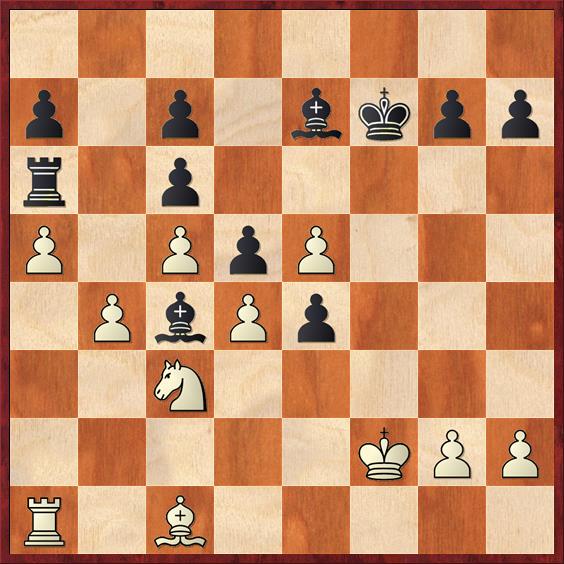 Position after 24. a5 (analysis). Black to move.
Position after 24. a5 (analysis). Black to move.
FEN: 8/p1p1bkpp/r1p5/P1PpP3/1PbPp3/2N5/5KPP/R1B5 b – – 0 24
I was amazed to see that Rybka evaluated this position (after 1 minute of analysis) as dead even. Even after an hour of thought, White’s advantage had only nudged up to + 0.28 pawns. This is crazy! White has to be winning. This is exactly the kind of position I’m looking for, because the Black rook is now well and truly wintered. I’d be curious to hear how more up-to-date computer programs like Komodo or Stockfish evaluate this position. Can Black really keep White at bay on the kingside, when White has a whole extra rook?
Okay, back to the game.
15. Qb3 Kh8 16. Bg5 Bf5
So far I’m doing pretty well. I’ve gotten two of my pieces out and slowed down Black’s attack; he had to move his king to get out of the pin on the a2-g8 diagonal and he had to move his bishop to protect the g6 square from forking threats. However, White is still skating on thin ice, and with my next move I get a little bit too careless.
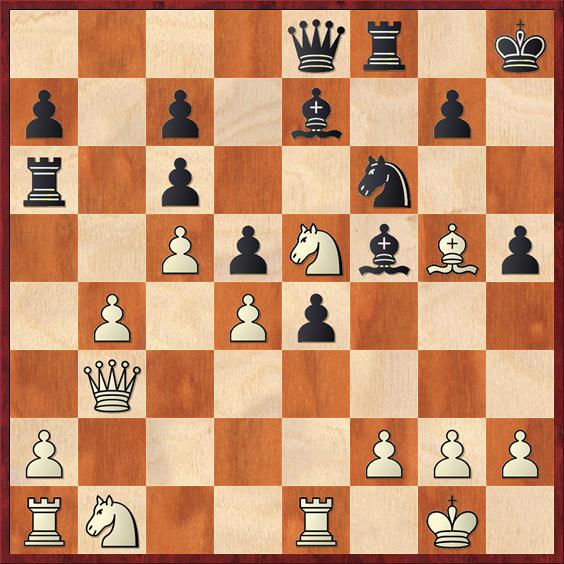 Position after 16. … Bf5. White to move.
Position after 16. … Bf5. White to move.
FEN: 4qr1k/p1p1b1p1/r1p2n2/2PpNbBp/1P1Pp3/1Q6/P4PPP/RN2R1K1 w – – 0 1
Here I debated for a long time between 17. Nd2 and 17. Nc3. Which one would you play, and why? Or would you play something different?
The moves 17. a4 and 17. h3 are definitely worth thinking about, but I don’t like them on general principles. White is continuing to move pawns instead of pieces. Why keep a potentially useful defender, the knight on b1, out of the game? Of course 17. h3 does have one good point: Black is clearly preparing to play … Ng4, and this move prevents it, so that he will now have to play a less aggressive move like … Nh7 or … Nd7 to further his attack. However, 17. h3 has the drawback that it gives Black a “hook” to attack on the kingside, so that eventually Black may be able to advance a pawn to g4 or sacrifice a piece on h3.
On general principles, therefore, I wanted to develop my knight. I wasn’t too afraid of … Ng4 because I thought the exchanges would weaken Black’s attack. So I played the move
17. Nc3?
The reason that 17. Nd2 is better than 17. Nc3 can be explained without calculating any variations. On c3, the knight interferes with the queen, so I will soon be forced to move it again. Where can it go to? The only reasonable square is d1, where it defends the f-pawn. But on that square, it interferes with the communication of White’s rooks, and it also prevents either rook from coming to d1 and defending the d-pawn. Quite likely the knight will continue to e3, but here, too it interferes with White’s other pieces! Both the queen and the rook might want to have access to the e3 square. Wherever it goes, the knight interferes with the harmony of White’s other pieces.
On the other hand, if I play 17. Nd2, I only have to move the knight once and it is not in the way of any other pieces. On d2 it serves a useful purpose, making it harder for Black to sacrifice a piece on f3. White’s pieces work together in harmony.
If you need a variation to convince you, Rybka says White is +0.7 after 17. Nd2 Ng4 18. Bxe7 Qxe7 19. Nxg4 Bxg4 20. Qe3 Qf6 21. a4 Qg6 22. h3 Bf3 23. Nxf3 ef 24. g3. But in this case, I think principles are better than variations. “Harmony” is an elusive concept in chess, but here’s a clear-cut case where one move has it and the other doesn’t.
Black continued with the plan of attack he has been preparing for:
17. … Ng4 18. Bxe7 Qxe7 19. Nxg4 Bxg4 20. Nd1 Qg5
The sacrifices on f3 didn’t work yet, but now Black’s threats are getting serious. Notice how he once again has a 3-piece advantage on the kingside. I have to bring in some defenders, but the knight, queen, and rook are all fighting over the e3 square. Which one should go there?
21. Qe3? …
A second mistake in an already difficult position. Both Rybka and my non-computer-aided analysis in 1998 say that White should play 21. Ne3. I wrote, “I think that 21. Ne3 would have held. 21. … Bf3 or 21. … Bh3 look impressive but don’t really threaten anything. After Kh1 or Kf1, the bishop is simply en prise.”
Well, it’s a bit more complicated than that. If 21. Ne3 Bh3 22. Kh1 White is leaving the f-pawn unguarded. Rybka says that Black draws after 22. … Rxf2 23. gh Ra3!! 24. Qxa3 Rxh2+!! 25. Kxh2 Qf4+. The only way that White can escape perpetual check is 26. Kg1 Qg3+ 27. Ng2, but that costs a queen and I agree with Rybka that Black stands better in the very complicated endgame that arises (Q+3P versus 2R+N!). The double rook sacrifice in this line is a nice anticipation of the double rook sac in the game, but the one in the game is even better!
So if White wants to play for a win, he first has to play 21. Ne3 Bh3 22. Qb2, to defend the f-pawn. Then after 22. … h4 23. Kh1, Black will have to retreat the bishop. Nevertheless, White has gotten himself into an ultra-passive situation, and it looks as if after 23. … Bd7 24. a4 h3 25. g3 the wintering of Black’s rook will be exactly compensated by the wintering of White’s entire kingside.
Of course, this computer ultra-precision bears little resemblance to imperfect human intuition. I chose 21. Qe3, most likely, because it looked more active.
21. … Qh4!
The computer points out that Black has a much simpler advantage after 21. … Qxe3, when White can take back in three different ways, none of them good! (a) 22. fe Rb8 wins a pawn. (b) 22. Rxe3 Bxd1 23. Rxd1 Rxa2 wins a pawn. (c) 22. Nxe3 Ra3. Trapped no more, Black’s rook can come to a nice active square at d3, and his bishop also can be repositioned to a nice diagonal with … Bc8 – a6. Black stands better. However, Waymouth’s move is better. He isn’t playing for the win of a pawn or a positional advantage: he’s playing for checkmate!
22. h3 …
I should have stuck to my plan of 22. a4, but I did not see what was coming. If 22. a4 Rf3 23. Qc1, Black is getting the better of it after 23. … Rb3 24. Qd2 Rd3. White simply can’t hang on to all of the vulnerable pawns, a4, b4, and d4. The knight isn’t doing a bit of good.
 Position after 22. h3. Black to move and win.
Position after 22. h3. Black to move and win.
FEN: 5r1k/p1p3p1/r1p5/2Pp3p/1P1Pp1bq/4Q2P/P4PP1/R2NR1K1 b – – 0 22
And here we are, at the position that puts this on my list of six most memorable games. By the way, you get zero credit if you guess Black’s 22nd move without seeing his 24th move. I saw the first one but didn’t see the second.
22. … Rf3!!
According to Rybka, 22. … Bf3 also works, but this move is a nuclear explosion.
23. gf …
Actually I originally hadn’t intended to take the rook. I was going to take the bishop with 23. hg Rxe3 24. Rxe3, but then I realized that after 24. … Qf6 I can’t defend the d-pawn. That damn knight on d1 again! Also declining both sacrifices with 23. Qc1 is inadequate, as Black continues to leave both the rook and bishop en prise with 23. … R6a3! A pretty finish would be 24. hg Rh3! 25. gh Rxh3, and there is no stopping mate on h1.
So there’s nothing better than sucking it up and taking the rook.
23. … Bxf3 24. Kh2 Ra3!!
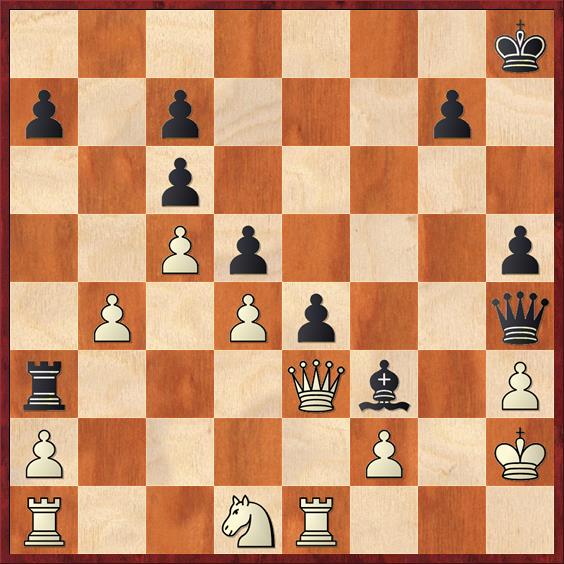 Position after 24. …Ra3. White to move.
Position after 24. …Ra3. White to move.
FEN: 7k/p1p3p1/2p5/2Pp3p/1P1Pp2q/r6P/P4P1K/R1QbR3 w – – 0 26
Nuclear explosion number two!
Another of Jesse Kraai’s favorite terms was “angry bishop” or “angry piece.” This is a piece, like Black’s QB in the French defense, that is cooped up for a very long time. Very often, when such a piece finally emerges from confinement, it completely changes the balance of power in the game. The opponent’s position, which was built under the assumption that the confined piece would never be a threat, completely collapses.
Black’s rook on a3 is very angry indeed!
Of course White can’t take because of 25. Qxa3 Qf4+ followed by mate in two. Retreating with 25. Qc1 also doesn’t work because 25. … Bxd1 leaves White bereft of good options, with both the f2 and h3 pawns hanging. I tried to soldier on into a Q-vs.-2R endgame, but it is not even close to playable.
25. Rg1 Rxe3 26. f3 Bxd1 27. Raxd1 Qf2+ 28. Rg2 Qxe3 29. Rb2?? …
Making it easy for my opponent. At this point I may have been in time trouble, and I was surely in a state of shell-shock. 29. R1d2 has to be played, but Black has many ways to win.
29. … Qf4+ White resigns.
I hope that you enjoyed this game as much as I didn’t enjoy it (at the time)! But painful as the defeat was, there were many, many things to learn from it.



{ 10 comments… read them below or add one }
I tried that position (8/p1p1bkpp/r1p5/P1PpP3/1PbPp3/2N5/5KPP/R1B5 b – – 0 24) on Komodo 9.3. The evaluation just keeps creeping up as the depth increases. Started out about 0.5 (depth 19), but now at depth=29 and saying + 1.68
Yup, what I expected! I think that Rybka’s evaluation of + 0.28 was also at depth = 19. It took an hour to get there because it’s only Rybka 3 and it’s on my laptop, which isn’t the world’s most powerful machine.
An interesting game, which reminds me of a classic Lasker game; his 4th against Tarrasch in the match 1908 (http://www.chessgames.com/perl/chessgame?gid=1241476). The difference is of course that Lasker intentionally sent his rook out in exile, and claims it was absolutely necessary to do so. I read about it years ago in an old TfS (Tidskrift för Schack), 1948/2 (http://www.schack.se/tfsarkiv/history/1948/tfs_1948_02.pdf), page 45 — it is in Swedish, of course, but there is always google translate…
Great game, a little bit different in themes but very similar to this one in the way that Tarrasch became preoccupied with the misplaced rook and perhaps let it distract him from the rest of the board.
Why not 14. f4, cementing your Ne5 or safely returning it to f3 with an open file for Re1? Same thought, again, at move 17.
And my first thoughts about keeping the Ra6 trapped were b3, and eventually a4. Defending the b3 pawn will be possible numerous ways, and only needed if yet another Black piece pressures it, anyway.
Your Rybka line that leads to a position in which Rybka counts the Ra6 as being worth a rook is humorous, but it takes a great deal of depth for a computer to devalue that rook. Of course, the position is dead won.
In any case, we’ve all had winning games which we’ve refused to win, and it’s always impressive that you can bring these out for public examination, as a way to improve yourself, and your readers (including me). Thanks!
Hi Hal! Definitely 14. f4 is worth considering. I just wasn’t comfortable with the amount of pressure he was getting after 14. … ef 15. Nxf3 Ne4.
On move 17 it may be good, too, but again there is a question of principle. Why am I pushing pawns when I could be developing pieces? Why am I playing on Black’s side of the board?
On the other hand I did like Rybka’s suggestion that IF Black plays a move like 14. … Nd7, then 15. f4 is totally worth playing, because Black will lose two tempi bringing his knight to e4. Of course, Rybka’s followup for Black, opening the f-file and trading major pieces, was completely absurd.
You’re right about b3 and a4 being an easier-to-achieve version of my plan. With b4 there was a danger of biting off more than I can swallow, which is exactly what happened.
Hello Dana,
I thought you wrote several great paragraphs, full of brilliant insights, in the original post,
I also loved the way you described your thinking process today and the way you made your assessments of various plans and candidate moves. I could see you applying many of the thinking techniques we have explored in my chess parties and it seems to be helping you.
But, I also thought your perception of why you lost the game, which I will paraphrase as ‘I played good strategic chess but lost because I put a piece on a bad square and then missed a tactic’, is completely wrong.
With your permission I would like to write a fairly long reply sharing my own thoughts on the game and on your thinking process. I think I have some major insights to share that would prove helpful to all non-master players
I really enjoyed this great post – it is chock full of food for thought.
BTW – I think your plan of b4 a4 a5 is slightly better than Hal’s idea of b3 and a4, even though it takes an extra tempo, because I would want to post the white rook on a3 and then swing it to the kingside. The other advantage is you can later play Qe2 to attack the wintered rook and it can’t escape to a5
-Mike
Mike – I look forward to your longer writeup. Dana gives us much food for thought!
Re: your idea of swinging the a1 rook via a3 to the K-side, I, too, envisioned a K-side attack, and swinging the rook rightward and then up to the 3rd rank as needed to guard the anchor pawn at b3 in my scenario. My f4 idea, in conjuncti0n with this, envisioned a K-side attack with an extra rook, if Black didn’t capture e.p., and use of the open files if he did capture on f3.
On the contentious Rybka position, Stockfish 64 also creeps up steadily, reaching +1.89 at depth 31 in about 10 minutes. (Stockfish is free, by the way, if you tire of Rybka.) The evaluation’s not very stable, though, going up sharply if you play its recommended move for Black. It’s not a very computerish position, I think.
Less than an hour ago Komodo clinched the victory in stage 2 of TCEC season 9 with a marvelous example of exploiting a wintered rook.
You can find the game back on http://tcec.chessdom.com/archive.php
1. e4 e5 2. Nf3 Nc6 3. d4 exd4 4. Nxd4 Nf6 5. Nxc6 bxc6 6. e5 Ne4 7. Qf3 Ng5 8. Qg3 Ne6 9. Bd3 Be7 10. O-O O-O 11. f4 f5 12. b3 d5 13. Nc3 Rb8 14. Kh1 c5 15. Qf2 Bb7 16. Ba3 Bc6 17. Rad1 Qe8 18. Ba6 Rd8 19. Bc1 Kh8 20. Bd3 Ba8 21. a3 Qh5 22. Ne2 Bh4 23. Qg1 a5 24. a4 d4 25. Bc4 Be4 26. Bxe6 Qxe2 27. Rd2 Qh5 28. Bc4 Rb8 29. Ba3 Be7 30. Qf2 Rb6 31. Qe2 Qh6 32. Rd3 Rg6 33. Rdf3 Rg4 34. h3 Rh4 35. Bd3 Qc6 36. Bc1 Rh6 37. Bd2 Qa8 38. Be1 Bd8 39. Kg1 Bd5 40. Bc4 Be4 41. Qd2 Bxf3 42. Rxf3 c6 43. Qd3 Bh4 44. Bd2 Qa7 45. c3 Bd8 46. Bc1 g6 47. Ba3 Re8 48. Kh2 Rh5 49. g3 Kg7 50. Qe2 Be7 51. Rd3 Rd8 52. Bb2 Qb6 53. Qd1 Kh6 54. cxd4 cxd4 55. Bxd4 Qb7 56. Bc3 Rxd3 57. Qxd3 Qa8 58. Qd7 c5 59. Bd5 Qd8 60. Qxd8 Bxd8 61. e6 Be7 1-0